
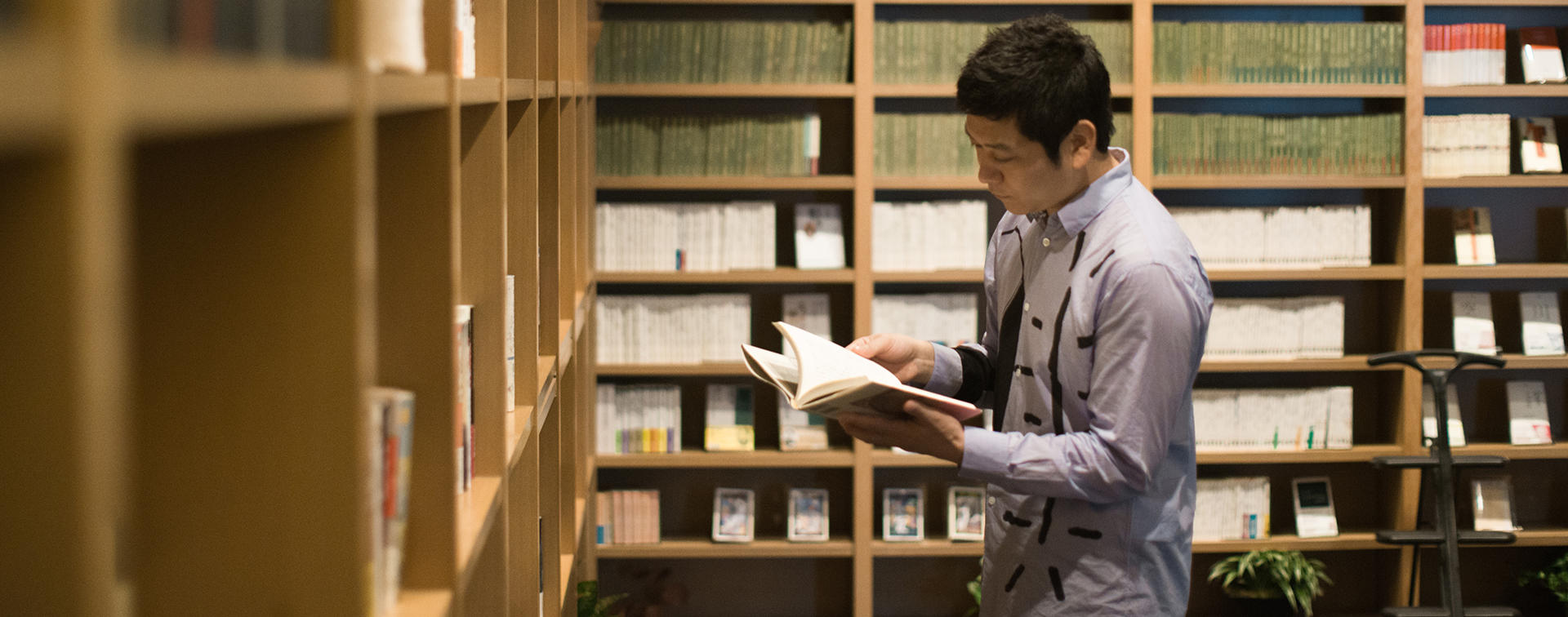

Sculpture and what lies beyond
Shifting from solo work to teamwork, expanting from sculpture to other projects
"Roppongi Art College" - a one-day event - was held on the 49th floor of Academy Hills. One of the features was a talk show - a Roppongi Future Talks interview held in front of an audience. The guest was sculptor Kohei Nawa who is known for works created with digital technology such as the 3D modeling system. Nawa talked about his memories of Roppongi, how his Kyoto-based studio "SANDWICH" was set up, and the stories behind his works. He also commented on subjects such as the relationship between artwork and space, and between architecture and cities.
Hanging out at the bar "Traumaris"
In 2003, the year I graduated from college, I received a prize for encouragement for the Kirin Art Award - a competition for contemporary art. It was then that I encountered the so-called art people for the first time; I hadn't come to Tokyo that often until then. The bar "Traumaris" which has now moved to Ebisu, was located in Imoarai-zaka slope, and every night I made drawings there or talked to artists of my generation. That bar was the only place I knew in Roppongi at that time, and it was where I hang out.
Roppongi has a sense of speed and chaos, doesn't it? I don't even know where the center of this area is, and I still haven't properly walked through its streets. Roppongi is totally different from Kyoto where I'm based. Kyoto is slightly more relaxed and quiet, and of compact size. The streets there have been made over a long span of time, so they seem to be well balanced. I think Kyoto is the opposite of Roppongi, which is a place where all kinds of stimulating things keep appearing.
Expressing the city and the times through sculptures
My doctoral thesis was on the theme of "sensibility and surface" and I wrote about my thoughts on sculpture in contemporary society. Looking at the cities of the world, I felt that commercial spaces are rapidly increasing and inflating. The shapes and textures born from capitalism were covering the surface of the cities. They are vacant, and some of them do not have any good effect at all on our sensibilities.
It seemed to me that products and architecture were being consumed, only to be replaced for further consumption, and that was also the way the towns were being made. I felt that the methods of contemporary capitalism are limited. I felt that if we keep putting priority on economic growth and simply go on running on the principle of competition, problems will eventually come up. I'd read books by Rudolf Steiner, and philosophical books on idealism, and I questioned what I saw.
"SCUM" is a work that was born as a sort of metaphor for all that. The word "scum" means foam or a slimy film. I thought of foam as representing stimulation; when foam fills a cup or a plate, it becomes big and bloated. In SCUM, the outlines of the objects have been made obscure, but I've also made a series of works called "PixCell" where the objects are covered with transparent glass beads. I've expressed in sculptures the state of the cities or the times we're living in - I'm not sure exactly which.
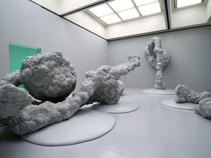
SCUM
An installation featuring objects covered with polyurethane foam spray. The coating expresses the way that sensations become bloated and dulled in a capitalist society. Apart from the works shown in the photos, there is also the "Villus" series which has definable outlines of various motifs.
"SANDWICH" - a workshop for one person turned into a studio for many
I currently work with several teams in a studio called "SANDWICH" which stands by the Uji River in Kyoto. At the center of our work is contemporary art, but we also do graphic design, and recently, we're making architecture in Japan and abroad, so we also have an office of a first-class registered architect. The studio was initially a place for just me, but it has evolved, and there are now several teams working there: there's an office team that manages projects and other teams engaged in production matters such as developing technology or researching materials or installing things.

SANDWICH
A studio set up in 2009 in Kyoto's Fushimi city for creative activities. In a space that spans approximately 500 square meters, Nawa and a roughly 40-member staff work in a wide variety of genres. The "SANDWICH" exhibition showing a distinctive worldview started in Dec. 7, 2013 at EYE OF GYRE in Omotesando and will be held until Feb. 16, 2014.
I suppose the way we are running this studio is experimental, but I wanted to change what was a workshop for one person into a space that would serve as a platform for many people. My wish was to draw in students, designers and architects, and to make a flat and neutral place which anyone could use - a playground-like place for everyone which was neither a college nor a company. I thought art college was like heaven - I was able to do anything I liked there, so I wanted my studio to be a similar kind of place.
In the past, I didn't have any thoughts at all of making this sort of place. I was searching for a studio that was larger than the one I was renting, and one day, a flier from a real estate agency in my postbox caught my eye. I was interested in the floor plan and rental fee, so I went to see the place. It was the former site of a factory and was on a riverbank. It was a much open place than I expected, and I thought it was nice that a breeze was always blowing. So I decided to move there.

A studio where something is always happening
The studio is named "SANDWICH" because there used to be a sandwich factory there. When I first visited the site, there was a dilapidated house and the remains of the factory such as discarded belt conveyers. In the beginning, the staff wasn't sure about the name of the studio and I was asked, "Are we really going to say 'sandwich' on the telephone?" I proposed that we make an effort until the name stuck; five years have passed since then.
The farmers in the neighborhood occasionally come and give us vegetables. Once, when we were transporting the "PixCell Deer" works, rumor apparently got round that young people were transporting a lot of deer, and we were asked, "Are you a theater troupe?" (laughs)

PixCell-Deer
Statues made from stuffed deer purchased via the Internet and which have been covered all over with crystal glass beads. They are part of the "BEADS" series and are Nawa's representative works. Deer PixCell-Deer#24 is kept at the Metropolitan Museum of Art in New York.
There are times when some of us are discussing architecture, while at the next table, a meeting is being held on an art project, and at the table beyond, people are making samples. Every day, many things are always happening inside the studio. All kinds of people are engaged in numerous projects on the same flat ground, so connections are naturally made between architectural projects and art projects, and conversations are easily struck up. It has become a kind of place I would have enjoyed coming to as a student.
But because we have to survive in the creative world, we can't afford to take a rest. In addition to my own exhibition, we are working on the student-based "Ultra Project" by the Kyoto University of Art and Design as well as many other projects ranging from graphics to architecture. The projects are so numerous; each time I walk inside the studio I come across some task that must be done. We also have a simple residence nearby, and we accept interns from Japan and abroad.
Indifference to what can be called art
Since SANDWICH was set up, the way we work and so many other aspects have changed drastically; it has made me realize that we are very much influenced by the place we are in. The staff members have gained experience, and I myself am learning a lot. A full-fledged architectural project has recently got underway and we are getting busier than ever. While architecture was one of the themes I studied in the past, I never imagined that I would own an architectural firm.
Many of my works require designing in millimeters whether it involves putting silicon oil into an aquarium and circulating foam inside it, or putting a stuffed specimen into a prism box. Thinking about a work involves thinking about the space that is appropriate for that work. Thinking about space essentially involves thinking about architecture, and I've come to the point where I no longer care about which parts of a work can be defined as art and which parts can be defined as architecture.
If someone tells me, "Please put a piece of artwork here", an idea for something that is simply like an interior decoration would not be very interesting, but I would find it interesting to make an artwork with architectural connotations. And when one thinks about transforming a certain space into an artistic space, an architectural approach inevitably becomes important, and one naturally becomes interested in learning more about architecture.
The similarities between sculpture and architecture
Creating shapes with a computer is actually not very different from designing architecture. For example, with the work "Trans", we made a 3D scan of a human body and developed a program to make the sculpture. With this method, voxels (a voxel is a box-shaped unit representing three-dimensional volume) is the common data used for making things from the tiniest object to the largest bulk - anything from humans to architecture. When dealing with voxels, the barriers of genre become irrelevant.
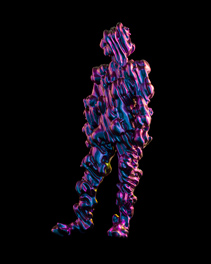
Trans
A group of works made by using the latest technology and 3D scanning. A unique program is used to manipulate and transform data gained from 3D scans of human bodies and objects. The works were shown in 2012 as a new sculpture series.
At the Setouchi Triennale 2013, we set up an installation called "Biota" inside a house designed by Kazuyo Sejima-san. First, a 3D image of Sejima-san's plan for the house was made and inside this image, I created shapes using a tactile device that allows me to touch digital clay. Design drawings were then made from those shapes to complete the work.
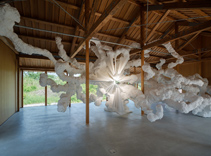
Biota(Fauna/Flora)
An installation made for the Inujima Art House Project whereby old houses are renovated for display. This was shown in the F-Art House which was designed by Kazuyo Sejima to coincide with the Setouchi Triennale 2013. A SCUM sculpture is placed in the middle of the two courtyards expressing fauna and flora.
So we make works by using computer data and real materials - touching both at the same time and going back and forth between the two worlds. There are times when something goes out of sync, and times when everything matches perfectly. When working like this for a while, I sometimes get the feeling that the real world is like a 3D image; that sensation is interesting.
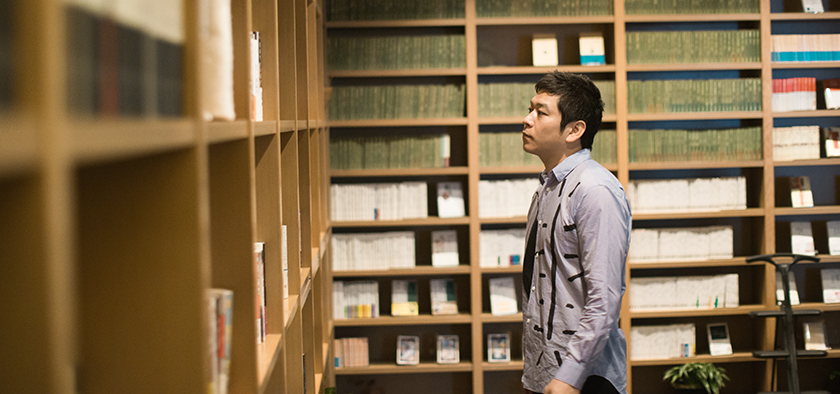
Artwork and cities are the realization of human thought
In architecture, there is a plan, and materials are procured to realize that plan. When you take that perspective, works and cities are the same in that they are both the realization of human thought. Until now, many of our exhibitions have been focused on the sensations inside a white cube, but recently, I feel that a crossover is occurring between each of our works.
For example, "Foam" which was exhibited at the Aichi Triennale is an installation of voluminous foams in a dark room which are constantly rising up and changing shape. In a huge landscape-like space, foams of many different shapes climb to a height of about three or four meters, and their shapes keep changing daily. It is the difference between the number of appearing foams and the number of disappearing foams which leads to the shape transformation, and I think that is very city-like - very architectural.
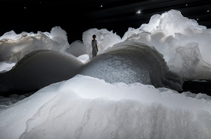
Foam
Installation exhibited at the Aichi Triennale. In a room of around 25 square meters, the ground is covered with gravel. Voluminous foams appear from the water placed in the middle. The foams constantly change shape according to gravity and air currents.
For the "Manifold" project, we set up a huge sculpture in the middle of Cheonan city, South Korea. We did the design in Japan, and the sculpting and model-making in China, pouring the aluminum into the molds. Then we brought the parts to Japan and welded each one, putting them together with the steel framework. In the final stage, we transported all the parts to South Korea and welded them together again; it was a big project that took two years.
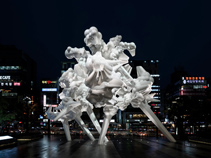
Manifold
A huge outdoor sculpture in Cheonan city, South Korea. Completed in June 2013, it stands 13 meters tall and has width of 16m and breath of 12m. It was made by putting together more than 200 molded and sculpted aluminum parts; a special tactile device and 3D data were used to create each part.
When we received the order to make this sculpture, we were asked to make something that would last 300 years. Three hundred years is such a long time - much longer than the life span of cities or streets. We cannot even tell whether the department store in front of our eyes will still be there, or how the streets will have changed. So we thought that it wasn't necessary to focus on just making a work that is in line with the current streets. Instead we made the sculpture while thinking about how its permanent presence could trigger change in the streets.
Building good teams, good relationships, good networks
I used to make works by myself, but the scale of the projects and works has gradually become bigger and now I have staff in charge of management and technology. The work I'm doing now seems to be similar to that of a movie director giving directions on shooting. But in making shapes, I personally have to be involved at the last stage, using my own body to make calculations. The good thing about the 3D system is that with the touching device, I can get tactile feedback on how the work actually feels. Because I can confirm what I am doing through physical sensations, the shape of the work never changes whether it is later made bigger or smaller.
When the materials differ, or when I am working in a different country or company, there are times when discrepancies appear. When that happens, I try to make corrections by pointing out the things that aren't right and or not to my taste. Sometimes, I get fixated about really small details, and people tell me, "I can't keep up with you," or "I'm never going to be involved in such a tough project again." Still, I have to do what has to be done.
Ultimately, when a work has been completed and it is of wonderful quality, or has led to something new, the team members want to get together again. We're doing all kinds of projects now and we're in the process of building good teams and good relationships, and good networks.
Something that exceeds the background of Roppongi
Have I ever thought of bringing SANDWICH to Roppongi? No, never. (laughs) Roppongi is an area teeming with so many things. I don't think you can easily gather people just by building a facility and setting up a program. To make something permanent, knowhow is needed and you also have to think about efficiency.
When I come to Roppongi, it's difficult to know where the center of the area is, and I sometimes notice that there are no children playing in the streets. The atmosphere of the area and the area's weak points are also things that need to be contemplated. If we were to hold an exhibition in Roppongi or were to create space or objects here, we would need to think of something that will exceed the background of Roppongi. If we could come up with solutions for all these challenges, then I would like to do something here.
Editor's thoughts
After the interview, I asked Nawa-san if he had any ideas for doing something specific in Roppongi. He said the same things he said in the interview, and then became silent in deep thought. "Roppongi is moving so much and I feel I can't grasp it," he said. Yet seeing the expression on his face, I felt that he had already come up with a good idea.(edit_kentaro inoue)



















